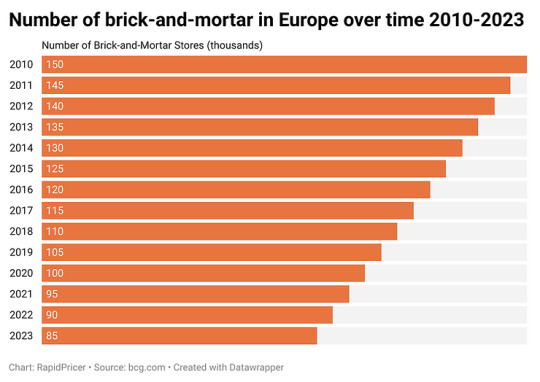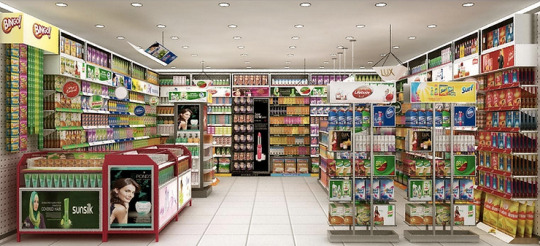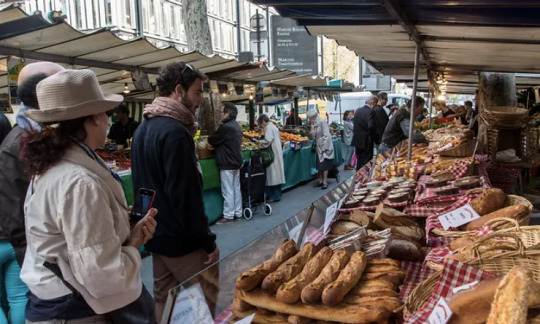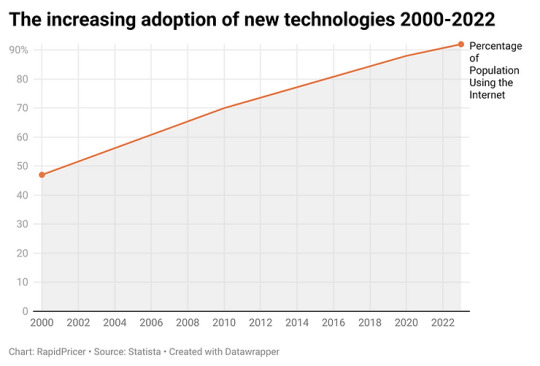#E-commerce growth
Text
#best marketing agency in Delhi#e-commerce growth#e-commerce marketing#Brand marketing#ROAS-focused strategies#performance marketing agency
0 notes
Text
Changing Landscape of European Retail
Written By: Jagriti Shahi

Figure: Growth of retail in Europe
The retail industry in Europe has undergone significant transformations in recent years, driven by changing consumer preferences, technological advancements, and global economic shifts. From traditional brick-and-mortar stores to e-commerce giants, European retail has seen a remarkable evolution. In this article, we will explore the key trends shaping the changing landscape of European retail and how businesses are adapting to stay competitive in this dynamic environment. The retail sector in Europe is the largest in the world, with a turnover of over €2 trillion in 2021. The sector employs over 20 million people and accounts for about 10% of the EU's GDP. The retail sector in Europe is highly fragmented, with a large number of small and medium-sized enterprises (SMEs). However, there are also a number of large multinational retailers operating in the market, such as Carrefour, Tesco, and IKEA.

Figure: Growth of retail in Europe
The retail sector in Europe is facing a number of challenges, including the rise of e-commerce, the changing demographics of consumers, and the increasing adoption of new technologies. The rise of e-commerce is one of the most significant challenges facing the retail sector in Europe. In 2021, online retail sales in Europe reached €768 billion, accounting for 16.1% of total retail sales. This growth is being driven by a number of factors, including the increasing availability of high-speed internet, the growing popularity of mobile shopping, and the convenience of online shopping.
Traditional brick-and-mortar retailers are struggling to compete with the convenience and lower prices of online retailers. In order to survive, traditional retailers are investing in their online presence and offering omnichannel experiences that allow customers to shop online and in-store. The demographics of European consumers are also changing, which is having an impact on the retail landscape. The population is aging, with more people over the age of 65. This group is increasingly active and affluent, and they are looking for different products and services than younger consumers. They are also more likely to shop online.
Another demographic trend is the increasing diversity of the European population. This is leading to a demand for more ethnic food and clothing stores. Retailers are also adapting their marketing and advertising to reach these new customer groups.
New technologies are also having a major impact on the retail landscape. The use of artificial intelligence (AI), augmented reality (AR), and virtual reality (VR) is growing, and these technologies are being used to improve the customer experience in a number of ways. For example, AI can be used to personalize recommendations, AR can be used to try on clothes virtually, and VR can be used to create immersive shopping experiences. The adoption of new technologies is also creating new opportunities for retailers. For example, retailers can use data analytics to track customer behavior and improve their marketing and product offerings. They can also use social media to connect with customers and build relationships.
The future of European retail is uncertain, but it is clear that the industry is undergoing a major transformation. The rise of e-commerce, the changing demographics of consumers, and the increasing adoption of new technologies are all having a major impact on the way people shop. Retailers that are able to adapt to these changes will be the ones that are successful in the future.

Figure: Brick-and-Mortar stores

Figure: Number of brick-and-mortar in Europe over time

Figure: Department stores
Department stores: Department stores are large stores that sell a variety of products, such as clothing, home goods, and electronics. Some of the most famous department stores in Europe include Galeries Lafayette in Paris, Selfridges in London, and El Corte Inglés in Madrid.

Figure: Independent retailers
Independent retailers: Independent retailers are small, privately owned businesses that sell a variety of products. These retailers often have a strong local presence and offer a unique shopping experience.

Figure: Markets
Markets: Markets are a great place to find fresh produce, meats, cheeses, and other local products. Many European cities have traditional markets that have been operating for centuries.

Figure: Outlet
Outlet malls: Outlet malls are a great place to find discounted name-brand clothing, shoes, and accessories. These malls are often located in tourist destinations.

Figure: Warehouse clubs
Warehouse clubs: Warehouse clubs are membership-only stores that sell a variety of products in bulk. These clubs are a great place to find discounts on groceries, household goods, and other items.
Traditional retail is still a major part of the retail landscape in Europe, and it is likely to remain so for the foreseeable future. These stores offer a unique shopping experience that cannot be replicated online. In addition, many traditional retailers are adapting to the changing retail landscape by investing in their online presence and offering omnichannel shopping experiences.
The European Retail Landscape
Europe boasts a diverse and rich retail heritage, with traditional shops, boutiques, and markets dating back centuries. These establishments have played a significant role in local economies, offering consumers a wide range of goods and personalized shopping experiences.
Challenges in the Digital Age: Traditional retail in Europe has felt the impact of the digital age. The rapid growth of e-commerce giants like Amazon, along with the convenience of online shopping, has led to a decline in foot traffic at brick-and-mortar stores. Consumers now have access to a vast array of products with the click of a button, making it essential for traditional retailers to adapt.
The Omnichannel Approach: Many traditional European retailers are responding to the digital challenge by adopting an omnichannel approach. This strategy combines physical stores with an online presence, offering consumers a seamless shopping experience. Retailers are investing in e-commerce websites, mobile apps, and in-store technology to bridge the gap between offline and online shopping.
Customer Experience and Personalization: One advantage traditional retailers have over e-commerce is the ability to provide a unique and personalized customer experience. Many European consumers still value the tactile, sensory experience of shopping in a physical store. Traditional retailers are focusing on creating welcoming and interactive environments, offering personalized service, and curating their product selections to cater to local tastes.
Sustainability and Localism: In response to consumer demand for sustainability and ethical shopping, traditional European retailers are emphasizing their commitment to local sourcing and environmentally friendly practices. Some are rediscovering the benefits of locally-produced goods, promoting them as eco-friendly alternatives to mass-produced items. This aligns with the rising trend of supporting local businesses and reducing the carbon footprint associated with global supply chains.
Cultural and Historical Significance: Traditional retail establishments often hold cultural and historical significance in European communities. Many have been in operation for generations, serving as cornerstones of local culture. These stores are cherished by residents and tourists alike, and efforts are made to preserve their historical authenticity while integrating modern retail practices.
Government Support: Some European governments recognize the importance of preserving traditional retail and are offering support through grants, subsidies, and regulatory measures. These initiatives aim to bolster traditional retail against the encroachment of e-commerce and maintain the vibrancy of city centers.
Conclusion
Traditional retail in Europe is at a crossroads. While it faces challenges from the digital age and changing consumer preferences, it also has unique advantages rooted in history, culture, and personalized shopping experiences. To thrive in today's retail landscape, traditional retailers must embrace technology, adopt an omnichannel approach, focus on customer experience, and align with sustainability and localism trends. In doing so, traditional European retail can not only survive but also continue to offer consumers a distinctive and cherished shopping experience that reflects the rich tapestry of Europe's retail heritage. By adapting to the evolving market while preserving their unique qualities, traditional retailers can continue to play a vital role in the continent's commercial landscape.
The changing demographics of consumers
The demographics of European consumers are also changing, which is having an impact on the retail landscape. The population is aging, with more people over the age of 65. This group is increasingly active and affluent, and they are looking for different products and services than younger consumers. They are also more likely to shop online.
Another demographic trend is the increasing diversity of the European population. This is leading to a demand for more ethnic food and clothing stores. Retailers are also adapting their marketing and advertising to reach these new customer groups.
Here are some specific examples of how the changing demographics of consumers are impacting the retail industry in Europe:
The aging population is leading to a demand for more accessible and convenient shopping options. This is driving the growth of online grocery delivery and click-and-collect services.
The increasing diversity of the population is leading to a demand for more ethnic food and clothing stores. This is also leading to a demand for products and services that cater to the needs of diverse cultures, such as halal food and bilingual customer service.
The rise of the digital native is leading to a demand for more personalized and engaging shopping experiences. This is driving the growth of mobile commerce and augmented reality (AR) shopping.
The changing role of women is leading to a demand for more flexible shopping hours and options for online shopping. This is also leading to a demand for more products and services that are designed for women, such as maternity clothing and baby products.
The growing importance of sustainability is leading to a demand for more sustainable products and services. This is driving the growth of organic food, fair trade clothing, and recycled packaging.
The increasing adoption of new technologies

Figure: The increasing adoption of new technologies
As you can see, the percentage of people in Europe using the internet has been increasing steadily over the past two decades. This is due to a number of factors, including the increasing availability of high-speed internet, the falling cost of computers and smartphones, and the growing popularity of online services.
The increasing adoption of new technologies is having a major impact on the retail industry in Europe. Here are some of the key technologies that are being adopted by retailers in Europe:
Artificial intelligence (AI): AI is being used to improve a variety of tasks in the retail industry, such as customer service, inventory management, and fraud detection. For example, AI can be used to analyze customer data to personalize recommendations, or to predict which products are likely to be in high demand.
Augmented reality (AR): AR is being used to create immersive shopping experiences that allow customers to try on clothes virtually or see how furniture would look in their home. For example, IKEA has an AR app that allows customers to see how its furniture would look in their living room.
Virtual reality (VR): VR is being used to create even more immersive shopping experiences that allow customers to virtually visit stores and try on products. For example, Amazon has a VR store that allows customers to browse its products and make purchases.
Internet of Things (IoT): IoT is being used to connect devices and collect data about customer behavior. This data can be used to improve a variety of tasks, such as inventory management and customer service. For example, retailers can use IoT sensors to track the movement of products in stores and to identify when products are running low.
Blockchain: Blockchain is being used to create secure and transparent supply chains. This can help retailers to ensure the authenticity of their products and to track their products from the source to the customer. For example, Walmart is using blockchain to track the supply chain of its food products.
These are just some of the key technologies that are being adopted by retailers in Europe. The adoption of these technologies is helping retailers to improve their efficiency, personalize the customer experience, and create a more sustainable supply chain.
E-Commerce Dominance
One of the most profound shifts in European retail has been the rise of e-commerce. Consumers now have the convenience of shopping online from the comfort of their homes, and this trend has been accelerated by the COVID-19 pandemic. Major players like Amazon, Alibaba, and local champions such as Zalando and ASOS have expanded their reach across Europe, reshaping consumer behavior and expectations. Retailers have had to invest heavily in their online presence, enhancing websites, mobile apps, and supply chain logistics to meet the demand for digital shopping. Additionally, omnichannel strategies have become essential, allowing consumers to seamlessly switch between online and offline shopping experiences.
E-commerce dominance refers to the growing market share of online retailers over traditional brick-and-mortar stores. This trend is being driven by a number of factors, including the increasing availability of high-speed internet, the growing popularity of mobile shopping, and the convenience of online shopping. In Europe, e-commerce sales are expected to reach €768 billion in 2022, accounting for 16.1% of total retail sales. This growth is being driven by the increasing adoption of online shopping by consumers across all demographics.
There are a number of reasons why e-commerce is becoming so dominant. First, the availability of high-speed internet has made it possible for consumers to shop online quickly and easily. Second, the popularity of mobile shopping has made it possible for consumers to shop online from anywhere. Third, the convenience of online shopping is unmatched by traditional brick-and-mortar stores. Consumers can shop online 24/7, compare prices from different retailers, and have products delivered to their door. The rise of e-commerce is having a major impact on the retail industry. Traditional brick-and-mortar stores are facing increasing competition from online retailers, and many are struggling to compete. In order to survive, traditional retailers need to adapt to the changing retail landscape by investing in their online presence and offering omnichannel shopping experiences.

Figure: Share of online retail sales in Europe over time
As you can see, the share of online retail sales in Europe has been increasing steadily in recent years. This is due to the increasing popularity of online shopping, which is more convenient and offers a wider selection of products. The share of online retail sales is expected to continue to increase in the coming years. However, it is important to note that not all countries are affected equally. For example, the share of online retail sales is higher in Northern Europe than in Southern Europe. The future of online retail in Europe is bright. The growth of online shopping is being driven by a number of factors, including the increasing availability of high-speed internet, the growing popularity of smartphones and tablets, and the increasing convenience of online shopping.
Sustainability and Ethical Consumption
The European retail landscape is witnessing a significant shift towards sustainability and ethical consumption. Consumers are becoming increasingly aware of the environmental and social impact of their purchases. Retailers are responding by adopting eco-friendly practices, sourcing sustainable products, and promoting transparency in their supply chains.
Fashion brands, in particular, have made strides in sustainable fashion, with initiatives like "slow fashion" and clothing rental services gaining popularity. European consumers are favoring products that are produced responsibly and have a lower environmental footprint, and retailers are aligning their strategies with these values.
Personalization and Data Analytics
Data analytics and artificial intelligence are playing a crucial role in the transformation of European retail. Retailers are harnessing the power of big data to gain insights into consumer behavior, preferences, and shopping habits. This data-driven approach allows them to personalize marketing efforts, optimize inventory management, and enhance the overall shopping experience.
Personalized recommendations, targeted advertising, and tailored promotions are becoming the norm in the industry. Retailers are using predictive analytics to forecast trends and adjust their product offerings accordingly, ensuring they stay ahead of consumer demands.
Pop-Up Stores and Experiential Retail
While online shopping continues to grow, physical stores are not becoming obsolete. Instead, retailers are reimagining the in-store experience to attract and engage customers. Pop-up stores and experiential retail spaces are gaining popularity, offering unique and immersive experiences that cannot be replicated online.
These temporary stores allow retailers to test new products and connect with customers on a more personal level. They often incorporate interactive elements, such as virtual reality experiences or live demonstrations, to create memorable moments for shoppers.
Cross-Border Expansion
European retailers are increasingly looking beyond their home markets for growth opportunities. Cross-border expansion has become a viable strategy for many companies seeking to tap into new customer bases and diversify revenue streams. The European Union's single market has facilitated this expansion by reducing trade barriers and harmonizing regulations.
Furthermore, technology has made it easier for retailers to reach international customers through e-commerce platforms and digital marketing. As a result, many European brands are expanding their presence into neighboring countries and even outside of Europe, creating a more competitive and globalized retail landscape.
Post COVID European Retail
The retail industry in Europe is undergoing a period of change after COVID. The pandemic has accelerated the shift to online shopping, and brick-and-mortar stores are struggling to compete. Retailers are responding by adopting new technologies, such as AR and VR, and by offering more convenient shopping experiences, such as BOPIS. The industry is also focusing on sustainability, as consumers are increasingly demanding sustainable products and services.
Conclusion
The changing landscape of European retail is characterized by the rapid growth of e-commerce, a focus on sustainability and ethical consumption, data-driven personalization, experiential in-store experiences, and cross-border expansion. Retailers that adapt to these trends and embrace digital transformation are likely to thrive in this dynamic environment.
The future of European retail will continue to be shaped by evolving consumer preferences and technological innovations. To stay relevant, retailers must remain agile, customer-centric, and committed to ethical and sustainable practices. As the industry continues to evolve, it will be exciting to see how retailers innovate and compete in this ever-changing landscape.
About RapidPricer
RapidPricer helps automate pricing, promotions and assortment for retailers. The company has capabilities in retail pricing, artificial intelligence and deep learning to compute merchandising actions for real-time execution in a retail environment.
Contact info:
Website: https://www.rapidpricer.com/
LinkedIn: https://www.linkedin.com/company/rapidpricer/
Email: [email protected]
#European Retail Industry#Retail Trends in Europe#E-commerce Growth#Brick-and-Mortar Stores#Omnichannel Retailing#Digital Transformation#Consumer Behavior#Sustainability in Retail#Retail Technology#Online Marketplaces#Supply Chain Disruptions#Post-Pandemic Retail#Retail Innovation#Mobile Shopping#Data Analytics in Retail#Cross-Border Shopping#Pop-Up Stores#Customer Experience#Retail Competition#Retailer Partnerships#Retail Regulations#Future of Retail in Europe#Retail Challenges#Local vs. Global Retailers#Retail Adaptation Strategies
0 notes
Text
E-Commerce Trends for 2023: The Future of Online Shopping

The e-commerce industry has been evolving rapidly over the past few years, driven by technological advances and changing consumer behaviors. As we move into 2023, this pace of change is set to continue, offering exciting opportunities for online retailers willing to innovate and adapt. Let's explore the key trends that will shape the e-commerce landscape in 2023.
1. The Rise of Social Commerce
Social commerce, the integration of e-commerce into social media platforms, is set to dominate in 2023. Social media giants like Facebook, Instagram, and Pinterest have rolled out shopping features, allowing businesses to sell directly through their platforms. This blurs the line between socializing and shopping, providing a seamless and engaging shopping experience.
Optimizing for Social Commerce
As social commerce grows, businesses should optimize their social media profiles for sales, using high-quality images, detailed product descriptions, and easy checkout processes. Engaging with customers on these platforms, through comments, messages, and user-generated content, will also be key to success.
Furthermore, businesses should explore integrating chatbots into their social commerce strategy. These AI-powered assistants can provide customer service, answer queries, and even facilitate transactions, providing a more personalized shopping experience.
2. Sustainability Takes Center Stage
More consumers are considering the environmental impact of their purchases. They're seeking out brands that prioritize sustainability, from their products to their packaging and delivery methods. This trend towards "conscious consumerism" is expected to grow in 2023, pushing more e-commerce businesses to adopt sustainable practices.
Embracing Sustainability in E-commerce
Brands can appeal to conscious consumers by offering eco-friendly products, using sustainable packaging, offsetting carbon emissions, and showcasing their commitment to social and environmental causes. Businesses should communicate their sustainability efforts transparently and authentically, as consumers can be skeptical of "greenwashing".
Additionally, businesses could explore circular economy models, which aim to eliminate waste and promote the continual use of resources. This could involve offering product take-back programs, refurbishing old products, or creating products from recycled materials.
3. AI and Machine Learning Enhance Personalization
Artificial Intelligence (AI) and Machine Learning (ML) technologies are becoming increasingly sophisticated, enabling highly personalized shopping experiences. These technologies can analyze a customer's behavior and preferences to provide personalized product recommendations, content, and offers.
Leveraging AI and ML in E-commerce
In 2023, expect more e-commerce businesses to leverage AI and ML for personalization, improving customer engagement and conversion rates. However, they must do so responsibly, ensuring they respect customer data privacy.
AI and ML can also be used to improve other aspects of the e-commerce experience. For instance, AI chatbots can provide personalized customer service, while ML algorithms can optimize inventory management and predict future sales trends.
4. Voice Commerce Grows in Popularity
With the rise of smart speakers like Amazon's Echo and Google Home, more people are using voice commands to do their shopping. This trend is expected to continue in 2023, with more e-commerce businesses optimizing their sites for voice search.
Optimizing for Voice Commerce
To tap into the voice commerce trend, businesses should ensure their website is voice-search friendly. This involves using natural language in their content and focusing on long-tail keywords, as voice searches tend to be longer and more conversational than text searches.
Businesses should also consider developing their own voice apps, or "skills", for smart speakers. These could allow customers to check their order status, browse products, or make a purchase, all through voice commands.
5. Augmented Reality Enhances Online Shopping
Augmented Reality (AR) offers a solution to one of the main challenges of online shopping: not being able to see or try products in person. AR technology allows customers to visualize products in their own environment, whether it's trying on clothes, testing out makeup, or seeing how furniture looks in their home.
Integrating AR into the Shopping Experience
As AR technology becomes more accessible, expect more e-commerce businesses to incorporate it into their online shopping experience in 2023. Businesses can use AR to provide virtual try-ons, product demonstrations, or interactive product visualizations.
But AR isn't just for product visualization. It can also be used to create engaging marketing campaigns, like interactive product catalogs or AR treasure hunts. Moreover, AR can enhance the in-store shopping experience for omnichannel retailers, allowing customers to access additional product information, reviews, or personalized recommendations.
6. Mobile Shopping Continues to Dominate
Mobile commerce, or m-commerce, has been growing rapidly, with more people using their smartphones to shop online. This trend is set to continue in 2023, making it crucial for e-commerce businesses to have a mobile-friendly website or app.
Optimizing for Mobile Commerce
A mobile-friendly shopping experience includes fast loading times, easy navigation, secure payment options, and a smooth checkout process. Google's shift to mobile-first indexing also makes mobile optimization a must for SEO.
Businesses should also consider developing a mobile app, which can provide a more personalized and engaging shopping experience than a mobile website. Apps can offer features like push notifications, loyalty programs, and offline browsing, and they typically have higher conversion rates than mobile websites.
7. The Growth of Omnichannel Retail
Omnichannel retail, which provides a seamless and integrated shopping experience across multiple channels, continues to be a significant trend in 2023. It's not just about being present on multiple channels, but ensuring those channels work together cohesively.
Excelling in Omnichannel Retail
Customers might discover a product on social media, research it on a brand's website, and then purchase it through the brand's app. They expect the transition between these channels to be seamless, with their preferences and shopping history carried over.
To succeed in omnichannel retail, e-commerce businesses need to have a deep understanding of their customer journey across all touchpoints and ensure they provide a consistent and personalized experience. This involves having a unified view of customer data, enabling real-time personalization and cross-channel marketing campaigns.
8. The Evolution of Payment Options
As e-commerce evolves, so do the ways customers can pay for their purchases. Digital wallets like Apple Pay and Google Pay provide a fast and secure way to pay, and their use is expected to grow in 2023. Cryptocurrencies, led by Bitcoin, are also being increasingly accepted by e-commerce businesses.
Adapting to New Payment Options
Offering a variety of payment options can enhance the customer experience and potentially increase conversion rates. However, e-commerce businesses must ensure they have the necessary security measures in place to protect customer data.
In addition to digital wallets and cryptocurrencies, businesses should also consider offering "buy now, pay later" options. These services, like Afterpay and Klarna, allow customers to split their purchase into several interest-free payments. They've been growing in popularity, especially among younger consumers, and can help increase average order values and conversion rates.
9. The Importance of Fast and Flexible Delivery
Fast and flexible delivery options have become a key differentiator for e-commerce businesses. Amazon has set the bar high with its Prime service, and customers now expect fast, reliable, and often free delivery from all online retailers.
Innovating in Delivery and Fulfillment
In addition to speed, flexibility is also important. Customers appreciate options like choosing a specific delivery time, changing the delivery address after placing an order, or picking up their order from a local store or locker.
In 2023, expect to see more e-commerce businesses exploring innovative delivery solutions, such as drones or autonomous vehicles, to meet customer expectations. Same-day delivery and hyper-local delivery, where orders are delivered within a few hours, could also become more common.
Another trend to watch is the growth of micro-fulfillment centers. These are small-scale warehouses located closer to customers, enabling faster and more efficient order fulfillment. They can be particularly beneficial for grocery e-commerce, which requires the quick delivery of fresh products.
10. The Rise of Direct-to-Consumer Brands
Direct-to-consumer (D2C) brands, which sell directly to consumers through their own platforms, bypassing traditional retailers, are on the rise. These brands can offer lower prices by cutting out the middleman, and they have a direct relationship with their customers, allowing them to gather valuable data and feedback.
Embracing the D2C Model
In 2023, expect more D2C brands to emerge, and more traditional brands to explore D2C sales. This trend could disrupt traditional retail models and reshape the e-commerce landscape.
The D2C model allows brands to control every aspect of the customer experience, from product design to marketing to delivery. It also allows for more personalized marketing and customer service, as brands have a direct line of communication with their customers.
However, the D2C model also presents challenges, such as managing logistics and customer service in-house, and competing in a crowded online marketplace. Brands will need to differentiate themselves through unique products, compelling brand stories, and exceptional customer service.
11. Customer Retention Becomes Crucial
As the cost of acquiring new customers continues to rise, e-commerce businesses are focusing more on retaining their existing customers. It's often said that it costs five times more to attract a new customer than to keep an existing one, making customer retention a crucial aspect of e-commerce success.
Fostering Customer Loyalty
In 2023, expect to see more e-commerce businesses investing in customer loyalty programs, personalized marketing, and exceptional customer service to retain their customers.
Data will play a key role in these efforts, helping businesses understand their customers' behavior, preferences, and needs. With these insights, businesses can personalize their communication and offers, increasing customer satisfaction and loyalty.
12. The Growth of International E-Commerce
International e-commerce, selling to customers outside your home country, is another significant trend for 2023. As more people gain access to the internet, and cross-border payment and delivery solutions improve, the global e-commerce market is growing rapidly.
Going Global with E-Commerce
E-commerce businesses looking to tap into this trend will need to adapt their website and marketing for different languages and cultures. They'll also need to navigate international shipping, taxes, and regulations, and offer customer service in multiple languages.
However, the potential rewards are significant. By selling internationally, businesses can reach a much larger customer base and benefit from higher growth rates in emerging e-commerce markets.
Conclusion
The e-commerce industry continues to evolve, driven by technological innovation, changing consumer behaviors, and the ongoing effects of the COVID-19 pandemic. These trends for 2023 provide a glimpse into the future of e-commerce, offering exciting opportunities for businesses willing to adapt and innovate.
Staying ahead in the e-commerce game means staying informed about these trends and being ready to act on them. As we move into 2023, the most successful e-commerce businesses will be those that offer a seamless, personalized shopping experience, embrace innovation, and put the customer at the heart of everything they do.
From sustainability to social commerce, from AI and machine learning to the evolving payment options, each trend offers unique opportunities to connect with customers in new and meaningful ways. Remember, the key to success in e-commerce is understanding your customer, and these trends will provide you with more tools and strategies to do just that.
By leveraging these trends, e-commerce businesses can create more engaging and personalized shopping experiences, build stronger customer relationships, and ultimately drive growth and profitability.
Staying ahead in the e-commerce industry means not just knowing about these trends, but understanding how to apply them to your business in a way that creates value for your customers and drives your business forward.
So, as we look towards 2023 and beyond, it's clear that the future of e-commerce is bright. Businesses that embrace these trends, and adapt to the evolving needs and expectations of their customers, will be well-positioned to succeed in the ever-changing e-commerce landscape.
Get ready for an exciting year in e-commerce. Whether you're a small business just starting out, or an established retailer looking to stay ahead, these are the trends that will shape the industry in 2023. Embrace them, and your business will be well-positioned to thrive in the e-commerce landscape of the future.
Whether you're just starting your e-commerce journey or looking to take your online store to the next level, understanding these trends and integrating them into your strategy is key. 2023 promises to be a thrilling year for e-commerce. Let's seize these opportunities together and create the future of online shopping!
#E-commerce trends 2023#Future of e-commerce#Social commerce#Sustainability in e-commerce#AI in e-commerce#Machine learning in e-commerce#Voice commerce#Augmented Reality shopping#Mobile commerce trends#Omnichannel retail strategy#New payment options#Delivery and fulfillment innovation#Direct-to-consumer brands#Customer retention strategies#International e-commerce#E-commerce strategy#Online shopping trends#E-commerce innovation#E-commerce technology#E-commerce growth#E-commerce opportunities#E-commerce insights#E-commerce market trends#Future of online shopping#E-commerce business strategy
0 notes
Text
youtube
This Marketing Tactic 10X’d My ECommerce Business (No BS)
Are you ready to take your e-commerce business to the next level? This marketing tactic 10X’d my ecommerce business. In this no-BS overview video, I'll reveal the exact marketing tactic that skyrocketed my e-commerce business from $3k/month to a mind-blowing $30k/month in less than 30 days! There is no fluff, just accurate results.
Join me as I dive deep into the strategy, tools, and promotions that fueled this incredible growth. Learn how we leveraged giveaways, email marketing, SMS, and social media to create a massive buzz and drive insane sales. Plus, I'll share the key insights and lessons learned from this game-changing journey.
If you're serious about boosting your e-commerce sales and scaling your business, this is a must-watch! Get ready to revolutionize your approach to e-commerce and witness the power of a winning strategy.
Ready to take the plunge? Let's 10X your e-commerce success together! Don't miss out on this game-changing insight. Hit that play button now, and let's elevate your e-commerce game!
#this marketing tactic 10x’d my ecommerce business#marketing tactics boosts ecommerce business#mastermind ecommerce#email marketing strategy#online business growth#email marketing#sms marketing#how to scale your business#how to scale business#scaling a business#how to scale a business#ecommerce marketing strategies#e-commerce marketing tactics#e commerce marketing tactics#e-commerce marketing tactics no bs#marketing funnel#ecommerce business tips#marketing#Youtube
2 notes
·
View notes
Text
2 notes
·
View notes
Text
The importance of Good Website design and its impact on people and profits in 2024
The Importance of Effective Website Design on Business Success | The Big Shoutout
In today’s digital-first world, a business’s website often serves as the front door to its brand, greeting potential clients before any human interaction takes place. The quality of this greeting can set the tone for all subsequent business relationships. At The Big Shoutout, we understand that good website design transcends mere aesthetics—it acts as a crucial catalyst in influencing user…

View On WordPress
#business growth#Digital marketing#E-commerce Solutions#Exclusive Offers#Marketing Tools#Online Store#Promotional Discounts#SEO Tools#Webinar Access
1 note
·
View note
Text
https://instagram.com/stories/sneakers_envy/3053835269886938054?igshid=MDJmNzVkMjY=
Nous sommes ravis de vous accueillir sur notre réseau " INSTAGRAM " aujourd'hui pour une expérience immersive au cœur du business. Les stories sont un moyen fantastique de partager des moments authentiques et de communiquer avec notre public d'une manière directe et personnelle 😃

#startups#smallbusiness#marketing digital#business growth#innovation#socialmediastrategy#leadership#growth hacking#e commerce#digital marketing#business tips#success mindset#productivity#management#branding#marketingtips#contentmarketing#salesfunnel#customer experience#worklifebalance
14 notes
·
View notes
Text
Mastering E-Commerce: Navigating Goals for Optimal Online Success

In the vast expanse of e-commerce, success is not merely about existence; it's about standing out, thriving, and achieving sustainable growth. Without a meticulously crafted plan, your digital presence risks being lost amidst the ever-expanding digital crowd. Enter the pivotal concept: setting clear and ambitious goals. In this comprehensive guide, we delve into the essential goals of e-commerce, offering a roadmap to not just meet but exceed them, ensuring your venture's prosperity in the dynamic digital landscape.
#e-commerce objectives#goals of online business#e-commerce success factors#achieving e-commerce goals#strategic goals in e-commerce#e-commerce performance metrics#key performance indicators for online sales#maximizing e-commerce profitability#e-commerce growth strategies#measuring e-commerce success
0 notes
Text
Coinrule Brand
#marketing#business#digital marketing#branding#business growth#search engine optimization#certification#technology#e commerce
0 notes
Text
Digitalbiz Technology offers expert digital marketing solutions for businesses. Elevate your online presence with our SEO, PPC, and social media services.
#digital marketing solutions#SEO services#PPC management#Social media marketing#Website optimization#Online presence#Digital agency#Internet marketing#Business growth strategies#E-commerce solutions
0 notes
Text
Google Analytics Metrics for E-Commerce Business

To get people to visit their website, any marketer or business owner who plans to construct one must conduct extensive research and provide a ton of valuable material.
However, how can you be sure that the service you provide on your website will be of interest to visitors?
The success of your online marketing and campaign is contingent upon users visiting your website and assisting in the expansion of your business. Google Analytics is one such tool that keeps track of and logs this user activity. It's a well-liked service that tracks visitor traffic to any website. Put simply, this instrument aids in quantifying the quantity of individuals accessing and perusing a website. Google is the provider of this service. Organizations that wish to examine how people locate and utilize their websites can use this service for free.
It facilitates understanding of our marketing initiatives. Additionally, by gathering visitor data, it monitors a website's effectiveness. The analytics dashboard comprises dimensions and metrics for every report.
The COVID-19 outbreak caused the sudden closure of numerous enterprises. However, the e-commerce sector was booming and digitization was at its peak. There was fierce rivalry among marketers and business owners to create unique websites for their flourishing companies. These analytical tools are helpful in situations like this so we can improve the website and realize our full potential.
The Google Analytics dashboard is divided into
The audience
Customers, users, or traffickers who visit your website and use your services are your audiences. On the website, you may obtain details about their demographics, devices they use, interests (the stuff they are seeing), and habits. The marketer can make adjustments to the website to better meet the needs of customers based on the audience data that they have collected. The various user/audience types are:
● New viewers
● People who came to a certain page
● Viewers who finished a goal conversion
● Viewers who finished a transaction
Purchasing
This level deals with the method or channel used to send visitors to the website. Some of the marketing strategies that assist business owners in getting customers to view their websites are advertisements posted on social media platforms (Facebook, Instagram, etc.), search engines, website referrals (your link referred in another website), email ad campaigns, paid search (traffic from search engine marketing like google ads), and display (traffic from display advertising).
Google Analytics Acquisition facilitates access to the channel breakdown and traffic sources report for marketers and business owners.
For instance, there are numerous advertisements on Facebook home pages. We click on the advertisements if they meet our criteria, and we are then taken to that specific website. Let's say we come into a Myntra advertisement for lovely clothing. When we click on it, the product we want is displayed right away.
Google Analytics data assists company owners in refining and comprehending these advertising campaigns and marketing strategies to draw viewers to the website and use its offerings.
Behavior You should be aware
of the actions that your audience or customers take on your website once they visit it. Behavior is determined by a variety of factors, including the content the audience views, the number of pages they visit, how long they spend on each page, the products they view and add to their cart and a host of other activities they engage in while on the website.
Transformation
The decision a customer makes while on your website is known as a conversion. Marketers and business owners can use this information to enhance the customer journey if the customers have joined up or made a purchase that increases the business's profit.
Size
The user's geographic area and language (where the user is viewing the website), social media platforms (where users are viewing the website by clicking on advertisements posted on any social media platform, such as Facebook, Instagram, etc.), returning visitors who arrive at the website directly through typing the URL, email campaigns, and clicking on referred URLs from other websites are all considered dimensions of Google Analytics.
Crucial Google Analytics KPIs for Monitoring Business Expansion

A metric establishes standards for numerical measurement. Numbers make up metrics. A website's data can be calculated in several ways by Google Analytics, the most basic being at the user, session, and page view levels. Among the common metrics are:
Users: Any individual who visits or views the website. They won't be tallied as new users if they are the same viewer.
Sessions - Each time a user accesses the website and actively participates in any discussions. As soon as the visitor visits the website, the session begins. the meeting following thirty minutes of window activity.
Average Session Duration: The length of time the typical visitor spends on the website. This information may be used by any marketer to assess how users are interacting with the material on your website. Let's say a visitor views any content for a brief period. In that case, the marketer can alter the content to better fit the preferences of the audience.
New visitor to returning visitor ratio: The percentage of visits from the same guests. Marketers may monitor whether their advertisements are drawing in repeat visitors and keeping them interested. Recurring visitors are a sign of an expanding company.
Bounce Rate: The percentage of visitors that depart after only reading one page. It indicates whether the user is experiencing a technical problem with the website, whether the material on the page is pertinent to the user, and whether the marketing campaigns are bringing in the appropriate amount of traffic to the websites. Look at demographics (age and gender) if the website has a high bounce rate. This can help you create an ad campaign that targets the correct people. The quantity of pages viewed in a given session is known as "pages viewed." Keep track of how long visitors spend on any given website.
Goal completions: How often visitors finish the action they came to complete. Any activity, such as a consumer signing up, making a purchase, providing feedback, or using one of your services.
Benefits of GA include: tracking online traffic, understanding user behavior, improving SEO and content marketing, generating business ideas, improving e-commerce performance, revamping websites with Google Analytics, identifying the right audience, boosting online advertising with marketing analytics, and GA conversion tracking.
How would you determine whether your website is profitable?
A lot of businesses make websites to showcase their goods and services. They require a "web analytics tool" to measure the amount of people who visit their website, which is essential to the success of their firm. Google Analytics, or GA, provides comprehensive information about the performance of your website and online business. The more precise data we have, the more options there are for optimization and learning how everything is interconnected concerning business as a whole. Assuming that your advertising campaigns and overall marketing initiatives are successful, you should have a sizable number of both new and repeat consumers. However, it's your responsibility as a marketer to stay current with trends and adapt the website to the demands of your users.
The Google Analytics tool has several applications that are beneficial for expanding a business. This tool assists marketers in identifying and realizing their actual performance. Marketers should take full advantage of this free tool to reimagine their offerings for their gain. You can always look back on GA to see how well your site is performing, regardless of whether you utilize it as an active or passive tool.
Google Analytics measurements are a useful tool for business owners looking to improve their operations. The owners have to monitor the direction of their dynamic and demanding firm on a daily basis. They have to consider every facet of their business and it is challenging to stay on top of emerging trends. They can hire digital marketing specialists like Clickbox Agency, who assist your company in staying up to date with emerging trends and technology, to handle this portion of the work to save themselves the trouble.
#clickboxagency#digitalmarketing#onlinemarketing#digital marketing e commerce#Ecommerce Marketing Services#e-commerce#e-commerce marketing service#digital marketing#e-commerce for growth
0 notes
Text
E-Commerce Apparel Market To Reach $1,160.56 Billion By 2030
E-Commerce Apparel Market Growth & Trends
The global e-commerce apparel market size is expected to reach USD 1,160.56 billion in 2030, registering a CAGR of 8.6% during the forecast period, according to a new report by Grand View Research, Inc. This can be accredited to growing demand for apparel from developed countries.
Boom in the e-commerce segment has been acting as a promoter for global market growth. The luxurious brands, which formerly were limited to the superior section of the civilization, traveling to fashion destinations like Paris and Milan have embraced people of all classes via the e-commerce channel. Ease of Payments, accessibility, and easy return policies are all producing a push for the market and are expected to accelerate the market growth during the forecast period.
Moreover, a lockdown circumstance has been observed throughout the COVID 19, and it showed an impact on the apparel market due to delayed supply of the raw material products. However, it significantly impacted the supply chain of the apparel market and manufacturing of the apparel products, across the globe. Moreover, the increasing acceptance of the e-commerce channels from the customers owing to changing buying patterns after the COVID outbreak had created opportunities for the market players. Thus, the market is expected to witness a healthy market growth rate during the forecast period.
The children’s apparel segment has been growing at a faster pace than the men’s and women’s apparel segments. The increasing trend of children's fashion showcases a wide range of attractive products, which is likely to accelerate the consumption rate. The increasing participation of the children in various activities like sports and arts is also expected to drive demand for the appropriate apparel in the coming years.
In North America, the market is projected to show a lucrative growth rate of 8.7% from 2022 to 2030 owing to rising demand for the women’s apparel across the region. Additionally, the U.S. has a vast number of brands actively functioning in the market, which includes Tommy Hilfiger, Ralph Lauren, Hollister, and Calvin Klein. Thus, the market has deep roots in the region and has an enormous influence across the globe. Moreover, changing consumers’ preferences and lifestyles is expected to propel the market growth during the forecast period. Thus all these factors are estimated to drive growth of this market within this region.
Request a free sample copy or view report summary: https://www.grandviewresearch.com/industry-analysis/e-commerce-apparel-market-report
E-Commerce Apparel Market Report Highlights
In Asia Pacific, the market is expected to witness the fastest CAGR of 9.4% from 2022 to 2030 owing to growing demand for the men’s and children’s apparel from developing nations such as China and India
The women’s apparel type segment accounted for the highest revenue share of more than 68.0% in 2021 owing to the rising demand for these products from the developed regions such as Europe and North America
Europe dominated the market and accounted for the revenue share of more than 36.0% in 2021 owing to rising demand for the women’s apparel as a result of the growing purchasing power of the women towards clothing
The men’s apparel type segment is expected to foresee the second-fastest CAGR of 8.4% from 2022 to 2030 due to the growing fashion consciousness amongst millennials
E-Commerce Apparel Market Segmentation
Grand View Research has segmented the global e-commerce apparel marketbased on the type and region:
E-commerce Apparel Type Outlook (Revenue, USD Billion, 2017 - 2030)
Women’s Apparel
Men’s Apparel
Children’s Apparel
E-commerce Apparel Regional Outlook (Revenue, USD Billion, 2017 - 2030)
North America
U.S.
Europe
Germany
U.K.
France
Asia Pacific
China
Japan
Central & South America
Brazil
Middle East & Africa
South Africa
List of Key Players of E-Commerce Apparel Market
Wal-Mart Inc.
Amazon, Inc.
JD.com, Inc.
Alibaba Group Holding Limited
EBay Inc.
Shopify Inc.
Rakuten Group, Inc.
Browse Full Report: https://www.grandviewresearch.com/industry-analysis/e-commerce-apparel-market-report
#E-Commerce Apparel Market#E-Commerce Apparel Market Size#E-Commerce Apparel Market Trends#E-Commerce Apparel Market Growth#E-Commerce Apparel Market Sales
0 notes
Text
India is one of the fastest growing e-commerce market in the world with many brands adopting multi channel retailing. Here are few facts to understand the rise of omnichannel retail in India.
0 notes
Text
Japan E-commerce Packaging Market Size, Share, Trends, Demand, Future Growth, Challenges and Competitive Analysis
Japan E-commerce Packaging Market study by Data Bridge Market Research provides details about the market dynamics affecting this market, Market scope, Market segmentation and overlays shadow upon the leading market players highlighting the favourable competitive landscape and trends prevailing over the years.
Japan E-commerce Packaging Market report provides top to bottom assessment of the market with respect to income and developing business sector. The report encompasses several market dynamics while also evaluating the growth rate and the market value based on market dynamics and growth inducing factors. The industry analysis report is mainly explored under four major areas which are market definition, market segmentation, competitive analysis and research methodology. Japan E-commerce Packaging Market business report also covers strategic profiling of the major players in the market, comprehensive analysis of their fundamental competencies, and thereby keeping competitive landscape of the market in front of the client.
Access Full 350 Pages PDF Report @
Shifting shopping preference towards online due to convenience and the growing popularity of smart packaging are some of the drivers expected to boost E-commerce packaging demand in the market. Data Bridge Market Research analyses that the E-commerce packaging market is expected to reach the value of USD 13,396.98 million by the year 2029, at a CAGR of 16.0% during the forecast period. "Boxes" accounts for the most prominent product segment in the respective market, owing to the rise in the demand of E-commerce packaging. The market report curated by the Data Bridge Market Research team includes in-depth expert analysis, import/export analysis, pricing analysis, production consumption analysis, and climate chain scenario.
Highlights of TOC:
Chapter 1: Market overview
Chapter 2: Japan E-commerce Packaging Market
Chapter 3: Regional analysis of the Japan E-commerce Packaging Market industry
Chapter 4: Japan E-commerce Packaging Market segmentation based on types and applications
Chapter 5: Revenue analysis based on types and applications
Chapter 6: Market share
Chapter 7: Competitive Landscape
Chapter 8: Drivers, Restraints, Challenges, and Opportunities
Chapter 9: Gross Margin and Price Analysis
Key takeaways from the Japan E-commerce Packaging Market report:
Detailed considerate of Japan E-commerce Packaging Market-particular drivers, Trends, constraints, Restraints, Opportunities and major micro markets.
Comprehensive valuation of all prospects and threat in the
In depth study of industry strategies for growth of the Japan E-commerce Packaging Market-leading players.
Japan E-commerce Packaging Market latest innovations and major procedures.
Favorable dip inside Vigorous high-tech and market latest trends remarkable the Market.
Conclusive study about the growth conspiracy of Japan E-commerce Packaging Market for forthcoming years.
Some of the major market players engaged in the Japan E-commerce packaging market are International Paper, NIPPON PAPER INDUSTRIES CO., LTD., Mondi, Amcor Plc, Sealed Air, Rengo Co., Ltd., AptarGroup, Inc., WestRock Company, Yamakoh, Co., Ltd., CHUOH PACK INDUSTRY CO., LTD., and Holmen Iggesund, among others.
Browse Trending Reports:
Composite Cans Market
Pet Blow Moulder Market
Polyvinyl Chloride Pvc Dunnage Trays Market
Japan E Commerce Packaging Market
High Grade Bubble Wrap Market
About Data Bridge Market Research:
Data Bridge set forth itself as an unconventional and neoteric Market research and consulting firm with unparalleled level of resilience and integrated approaches. We are determined to unearth the best market opportunities and foster efficient information for your business to thrive in the market. Data Bridge endeavors to provide appropriate solutions to the complex business challenges and initiates an effortless decision-making process.
Contact Us:
Data Bridge Market Research
US: +1 888 387 2818
UK: +44 208 089 1725
Hong Kong: +852 8192 7475
Email: [email protected]
#Japan E-commerce Packaging Market Size#Future Growth#Challenges and Competitive Analysis#market report#market share#market trends#market size#market analysis#market research#markettrends#marketresearch#Japan E-commerce Packaging
0 notes
Text
Simplify Online Selling: Integrate ERPNext with Your Website by Sigzen
In today’s digital world, selling online is a must-do for businesses aiming to reach more customers and thrive. But managing an online store efficiently can be challenging without the right tools. That’s where ERPNext comes in. It’s like a super-powered assistant for your online business, helping you manage everything from inventory to customer orders seamlessly. Let’s explore how integrating…

View On WordPress
#business growth#business optimization#CRM#E-commerce Integration#Ecommerce Solutions#Financial Management#Inventory Management#Online Sales
0 notes
Text
Digitalbiz Technology: Empowering Businesses with Innovative Digital Solutions
#digital marketing solutions#SEO services#PPC management#Social media marketing#Website optimization#Online presence#Digital agency#Internet marketing#Business growth strategies#E-commerce solutions
0 notes